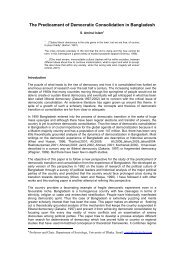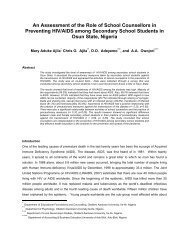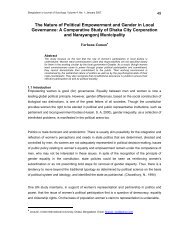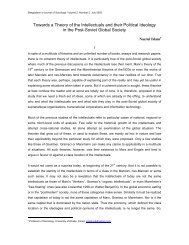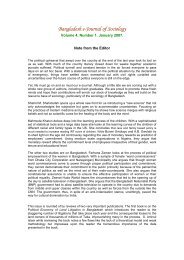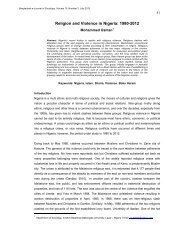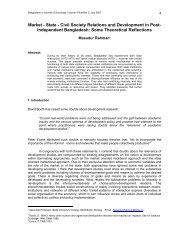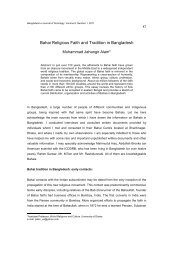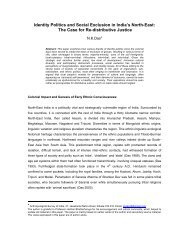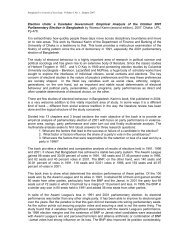Between Puritan Islamic and Syncretistic Muslim Traditions in
Between Puritan Islamic and Syncretistic Muslim Traditions in
Between Puritan Islamic and Syncretistic Muslim Traditions in
You also want an ePaper? Increase the reach of your titles
YUMPU automatically turns print PDFs into web optimized ePapers that Google loves.
Bangladesh e-Journal of Sociology. Volume 8, Number 1. 201164<strong>Between</strong> <strong>Puritan</strong> <strong>Islamic</strong> <strong>and</strong> <strong>Syncretistic</strong><strong>Muslim</strong> <strong>Traditions</strong> <strong>in</strong> Bengal:An Ecological Perspective on the Faraizi MovementIftekhar Iqbal*Abstract. In this paper I propose that the phenomenon of the Faraizi movement <strong>in</strong>n<strong>in</strong>eteenth-century Bengal can be expla<strong>in</strong>ed from the perspective of the ecologicalenvironment as well as <strong>in</strong> terms of its relation to reformist <strong>Islamic</strong> <strong>in</strong>fluence, to colonialhistorical processes <strong>in</strong> general <strong>and</strong> to Bengali syncretism <strong>in</strong> particular. In other words, <strong>in</strong>this paper I highlight the <strong>in</strong>terest<strong>in</strong>g fact that the Faraizi movement, which is the antithesisof syncretism, flourished <strong>in</strong> ecological conditions comparable to those <strong>in</strong> which somehistorians observe that religio-cultural syncretism emerged. Thus the central questionexplored <strong>in</strong> this paper is: how can we expla<strong>in</strong> the emergence of an <strong>Islamic</strong> reformistpuritanmovement under environmental conditions hitherto considered conducive tosyncretism?Historiographic considerationsThere are two broad reasons why environment matters <strong>in</strong> the discourse of modern history ofBengal. The first issue relates to the overall absence of environmental perspective <strong>in</strong> thehistoriography of modern eastern Bengal. This contrasts, surpris<strong>in</strong>gly perhaps, to historiographyof Bengal <strong>in</strong> earlier periods. For <strong>in</strong>stance, Abdul Mom<strong>in</strong> Chowdhury has discussed the role ofecology <strong>in</strong> the shap<strong>in</strong>g of different ancient dynastic traditions <strong>in</strong> the region. For medieval Bengal,H. Blochman <strong>and</strong> Richard Eaton have underl<strong>in</strong>ed the l<strong>in</strong>ks between deltaic environment <strong>and</strong>political <strong>and</strong> cultural development <strong>in</strong> the region. Interest<strong>in</strong>gly, however, not much remarkable workhas been published on the environmental context of colonial history of Bengal, although there isample evidence that environment cont<strong>in</strong>ued to play as significant a role <strong>in</strong> modern time as <strong>in</strong>ancient <strong>and</strong> medieval periods. 1 The second issue relates to the way <strong>in</strong> which environment hasbeen l<strong>in</strong>ked to syncretism. Historians like Eaton have tended to l<strong>in</strong>k religio-cultural syncretism tothe fluid, forested ecology of Bengal. In other words, such syncretistic practice as reliance onimag<strong>in</strong>ed or real pirs dur<strong>in</strong>g reclamation of fluid char (newly emergent alluvial) l<strong>and</strong>s or collectionof honey <strong>in</strong> the Sundarbans (tidal mangrove forests) has been regarded as a product of<strong>in</strong>teraction among peasantry of different religious <strong>and</strong> cultural backgrounds who must live <strong>and</strong>work together <strong>in</strong> a given environmental condition.*Assistant Professor, History, University of Dhakae-mail: iftekhar.iqbal@gmail.com1 For an environmental perspective on post-1947 Pakistan history, see Kamal 2005.
Bangladesh e-Journal of Sociology. Volume 8, Number 1. 201165The Faraizi movement: an overviewThe Faraizi movement was <strong>in</strong>itiated by Haji Shariatullah, who was born <strong>in</strong> the deltaic district ofFaridpur <strong>in</strong> 1781. At the age of eighteen, Shariatullah left Bengal to study Arabic literature, <strong>Islamic</strong>jurisprudence <strong>and</strong> Sufism <strong>in</strong> Mecca <strong>and</strong> al-Azhar University <strong>in</strong> Cairo. After return<strong>in</strong>g home <strong>in</strong>1820, he started a campaign to elim<strong>in</strong>ate from the Bengali <strong>Muslim</strong> society various traditionalpractices (riwaj) which he considered contradicted the teach<strong>in</strong>g of the Qu’ran. 2 Such riwaj<strong>in</strong>cluded the worshipp<strong>in</strong>g of the shr<strong>in</strong>es of pirs or sa<strong>in</strong>ts, participation <strong>in</strong> the ratha yatra or Purana<strong>in</strong>spiredreligious processions of the H<strong>in</strong>du community, the plant<strong>in</strong>g of a banana tree around theresidence on the occasion of the first menstruation of a girl, <strong>and</strong> so forth. 3 These practices, oftendescribed as shirk (idolatry) <strong>and</strong> bid’a (unlawful <strong>in</strong>novation), were the objects of Shariatuallah’scondemnation. But his attempt to cleanse the <strong>Muslim</strong> community from ‘syncreticistic <strong>in</strong>dulgences’of rural Bengal was not possible unless Islam was made relevant to the agrarian society.Shariatuallah <strong>and</strong> then his son, Dudu Mian, were able to do this amidst a complex series ofdevelopments that were tak<strong>in</strong>g place <strong>in</strong> n<strong>in</strong>eteenth century Bengal.Shariatuallah’s efforts towards religious reform came at a time when agrarian economy <strong>in</strong> Bengalwas undergo<strong>in</strong>g a remarkable transition. By 1830, the impact of the <strong>in</strong>dustrial revolution on textileproduction <strong>in</strong> Brita<strong>in</strong> was be<strong>in</strong>g fully felt <strong>in</strong> Bengal. This resulted <strong>in</strong> imported cotton productsquickly tak<strong>in</strong>g over from local ones, which became uncompetitive even <strong>in</strong> the domestic market.This, <strong>in</strong> turn, caused widespread unemployment or reduction <strong>in</strong> the earn<strong>in</strong>g of the weavers thatfell ‘below starvation wages’. About the same time, the impact of the worldwide depressionreached Bengal, thanks to an emerg<strong>in</strong>g l<strong>in</strong>kage between the capitalist centre <strong>and</strong> its dependentperiphery. In the early 1830s, major agency houses or f<strong>in</strong>anciers collapsed <strong>in</strong> Calcutta result<strong>in</strong>g <strong>in</strong>the reduction of the flow of credit <strong>and</strong> a drastic fall <strong>in</strong> prices. Many peasants were coerced to growan ‘unremunerative cash crop <strong>in</strong> return for paltry advances from <strong>in</strong>digo factories at a time whenrental dem<strong>and</strong>s cont<strong>in</strong>ued to be str<strong>in</strong>gent’ (Bose 1993). 4 In these highly volatile circumstances,Shariatullah’s call for resistance to undue taxes imposed by the zam<strong>in</strong>dars was enthusiasticallygreeted by both poor peasants <strong>and</strong> weavers. Shariatullah reportedly had comm<strong>and</strong> over about12,000 weavers who met the threat of unemployment <strong>in</strong> the traditional textile <strong>in</strong>dustry byengag<strong>in</strong>g <strong>in</strong> agriculture. With<strong>in</strong> a short period, therefore, Shariatullah not only appeared to be a2 For a life-sketch <strong>and</strong> activities of Haji Shariatullah, see Khan 1965, 1-22.3For an account of the syncretistic practices surround<strong>in</strong>g childbirth, death, marriage <strong>and</strong> circumcision <strong>in</strong> thencontemporary Bengali <strong>Muslim</strong> society <strong>and</strong> the Faraizi efforts to elim<strong>in</strong>ate them, see Taylor 1840, p. 240 <strong>and</strong> Khan 1965,pp. lxxxvii-lxxxviii.4 To some extent, the condition might be compared to the condition of ‘agricultural <strong>in</strong>volution’ <strong>in</strong> colonial Indonesia asdescribed by Geertz 1963.
Bangladesh e-Journal of Sociology. Volume 8, Number 1. 201166spiritual saviour, but also someone who, <strong>in</strong> 1837, was accused by some zam<strong>in</strong>dars of sett<strong>in</strong>g up ak<strong>in</strong>gdom like Titu Mir. 5It was the beg<strong>in</strong>n<strong>in</strong>g of a wave of peasantization.It was Muhs<strong>in</strong> al-D<strong>in</strong> Ahmad, alias Dudu Miyan, however, who consolidated the budd<strong>in</strong>g Faraizimovement. Dudu Miyan, a son of Haji Shariatullah, returned from Mecca <strong>in</strong> 1837 after complet<strong>in</strong>ghis education <strong>and</strong> took charge of the movement <strong>in</strong> 1840. 6 When Dudu Miyan took over, agrariancircumstances were not entirely similar to what they had been <strong>in</strong> the 1820s or 1830s. By 1840,the impact of the depression was beg<strong>in</strong>n<strong>in</strong>g to subside, the price of commodities was ris<strong>in</strong>g <strong>and</strong>the government’s favourable attitude to primary producers of agricultural commodities wasbecom<strong>in</strong>g apparent, while l<strong>and</strong> reclamation cont<strong>in</strong>ued extensively beyond the permanently settledareas. Dudu Miyan’s world, therefore, was larger than his father’s <strong>and</strong> he found far more followersaround him, which encouraged him to radicalize the idea of peasants’ rights as well as to take upa policy of aggressive resistance <strong>in</strong>stead of passive mobilization. He proclaimed that ‘Langol zar,zami tar’ (‘l<strong>and</strong> belongs to him who owns the plough’). 7 He brought forward before the peasantrythe idea of God’s sovereignty on earth by proclaim<strong>in</strong>g that the earth belonged to God, <strong>and</strong> that noone other than the lawful government had the right to lord over or impose taxes on it. 8 With DuduMiyan, thus, the Faraizi creed was transformed <strong>in</strong>to a full-fledged agrarian movement.Bengal Police estimated that Dudu Miyan had about 80,000 followers 9 , while Alex<strong>and</strong>er Forbes,editor of the Bengal Hurkaru, calculated it at 300,000. 10 On one occasion, when Dudu Miyan wasbe<strong>in</strong>g tried <strong>in</strong> a Court <strong>in</strong> Faridpur for his alleged <strong>in</strong>volvement <strong>in</strong> attempt<strong>in</strong>g to kill an <strong>in</strong>digo planter,about 3,000 boats filled with his followers stood ready at a river nearby just to protect DuduMiyan, <strong>in</strong> case of a negative verdict. Similarly, a witness to the Indigo Commission noted that sogreat was the apprehension of danger that an entire regiment <strong>in</strong> Dhaka was ordered to st<strong>and</strong>ready to tackle any <strong>in</strong>cidents. It was also commonly believed that Dudu Miyan’s acquittal <strong>in</strong> theabove case was the ‘result of fear on the part of the Government’. Dur<strong>in</strong>g the Sepoy <strong>in</strong>surrectionof 1857, Dudu Miyan was arrested <strong>and</strong> kept <strong>in</strong> jail as a pre-emptive measure. The story went thathe would have been released if he had not boasted that he could summon 50,000 people at anytime to march <strong>in</strong> whatever direction he so desired. Gastrell, dur<strong>in</strong>g his survey of three districts of5 Titu Mir was a heroic peasant leader who enlisted the support of numerous peasants to wage jihad (struggle) aga<strong>in</strong>st thel<strong>and</strong>lords <strong>and</strong> the Raj. After <strong>in</strong>itial success, he died resist<strong>in</strong>g a colonial army <strong>in</strong> 1831. For a detailed discussion of TituMir’s life <strong>and</strong> his <strong>in</strong>fluence on subsequent peasant movements, <strong>in</strong>clud<strong>in</strong>g the Faraizis, see Khan 1977 <strong>and</strong> 2003.6 Gastrell 1868, p. 36 reported that on Shariatullah’s death his followers assembled, <strong>and</strong> by ‘common consent’ namedDudu Miyan as the head of the Faraizis.7 Muhibudd<strong>in</strong> Ahmad, pp.14-15.8 Accord<strong>in</strong>g to Khan 1965, p. 114, follow<strong>in</strong>g the Quranic verse ‘whatever is <strong>in</strong> the heavens <strong>and</strong> <strong>in</strong> the earth belongs toGod’ (Quran, 4:131), Dudu Miyan declared that the l<strong>and</strong> was the bounty of God, <strong>and</strong> man be<strong>in</strong>g His most favouredcreature had equal right to exploit this ‘div<strong>in</strong>e gift’. L<strong>and</strong>, therefore, accord<strong>in</strong>g to the Faraizis, belonged to those who hadexploited it. This <strong>in</strong>terpretation not only helped the peasantry to perceive the zam<strong>in</strong>dari exploitation <strong>in</strong> terms of illegal taxesas gross <strong>in</strong>justice; it also legitimized their settlement <strong>in</strong> the reclaimed <strong>and</strong> newly formed l<strong>and</strong>s <strong>in</strong> the delta. See also Wise1883, p. 24.9 University of Cambridge Library, Add. MS. 7490/39/4: ‘Correspondences relat<strong>in</strong>g to the Wahabi movement’.10 M<strong>in</strong>utes of Evidence (henceforth MoE), Indigo Commission Report, 1861, answer no. 3979.
Bangladesh e-Journal of Sociology. Volume 8, Number 1. 201167eastern Bengal between 1856 <strong>and</strong> 1862, noted that the number of the Faraizis was ‘annually <strong>and</strong>steadily <strong>in</strong>creas<strong>in</strong>g’ (Gastrell 1868).The number of followers of the Faraizi movement seemed to cont<strong>in</strong>ue to grow dur<strong>in</strong>g Dudu Mian’sson Noa Miyan’s time. In an essay on the subject of revival of Islam, published <strong>in</strong> The Times <strong>in</strong>1873, the writer remarked that year after year Islam was convert<strong>in</strong>g ‘hundreds of thous<strong>and</strong> of theIndians, especially the natives of Bengal, to the faith of Koran’. 11 In response, Isaac Allen wrote <strong>in</strong>the Calcutta Review the follow<strong>in</strong>g year that he did not believe that conversion was tak<strong>in</strong>g place onsuch a scale. But Allen thought that a ‘possible explanation of the above errors might be found <strong>in</strong>the rapid conversion of Sunnis <strong>and</strong> Shiahs <strong>in</strong>to Ferazis or Wahabis, which had taken place dur<strong>in</strong>gthe last 20 or 30 years.’ This picture of the numerical strength of the Faraizis is matched by thefact, as claimed by their contemporary adversaries, that each of the three Faraizi leadersmentioned above acted as a sovereign or established a ‘parallel government’. Some latter dayhistorians also have supported this assertion. 12Thus we can attribute the success of the Faraizi movement to the Bengal environment <strong>in</strong> differentways. Firstly, the Faraizis had found a place <strong>in</strong> the chars <strong>and</strong> forests to earn their livelihood <strong>in</strong> aflexible way unlike the regimentation <strong>in</strong> the older places under the l<strong>and</strong>lords. Secondly, <strong>in</strong> terms ofpolitical strategy, they had developed the slogan ‘langol zar, zami tar’, which signified theirfundamental anchorage to l<strong>and</strong>. Thirdly, the Faraizis used waterways of the region <strong>in</strong> their favourto establish communication, mobilize supporters <strong>and</strong> facilitate market<strong>in</strong>g. But the questionrema<strong>in</strong>s: how could that happen at a time when the British Raj was bask<strong>in</strong>g <strong>in</strong> its politicalsupremacy throughout India?It seems that the Faraizis had built up a horizontal coalition among the peasants of differentreligious <strong>and</strong> social backgrounds aga<strong>in</strong>st any threat to their <strong>in</strong>terests posed by the l<strong>and</strong>ed elite orother ‘outsiders’. This broader social basis of resistance put them on solid ground for barga<strong>in</strong><strong>in</strong>gwith the government to secure <strong>and</strong> defend their <strong>in</strong>terests. 13 Alex<strong>and</strong>er Forbes testified to theIndigo Commission that religion had noth<strong>in</strong>g to do with the <strong>in</strong>fluence of Dudu Miyan <strong>and</strong> that thiscould be understood from the fact that one of the Faraizi factions was then led by a H<strong>in</strong>du. 14 Therelative stability <strong>in</strong> relations between different communities was reflected <strong>in</strong> the non-<strong>in</strong>terferenceof the Faraizis <strong>in</strong> the affairs of other religious communities. At the same time, the movementseemed to have been consolidated by a strong antipathy aga<strong>in</strong>st all categories of l<strong>and</strong>ed elite of11The Times, 29 August 1873 , p.7.12About the Faraizi quest for autonomy <strong>and</strong> ‘<strong>in</strong>dependent statehood’, see Choudhury 2001, pp. 56-61 <strong>and</strong> Bose 1993,p.151.13 For a Marxist approach to the Faraizi movement, see Kaviraj 1982.14 MoE, answer no. 3979.
Bangladesh e-Journal of Sociology. Volume 8, Number 1. 201168Bengal. 15 But how do we relate this populist political st<strong>and</strong> of the Faraizis with environmentalelements of the delta? We can exam<strong>in</strong>e this issue by a case study of <strong>in</strong>digo plantations.Forg<strong>in</strong>g Islam <strong>in</strong> local agro-ecology: the Faraizis <strong>and</strong> the <strong>in</strong>digo plantersThe best <strong>in</strong>digo l<strong>and</strong>s, accord<strong>in</strong>g to several witnesses to the Indigo Commission, were thosewhich were subject to <strong>in</strong>undation dur<strong>in</strong>g the ra<strong>in</strong>y season <strong>and</strong> which rema<strong>in</strong>ed submerged for twoto three months. The cultivation of <strong>in</strong>digo was, therefore, more conf<strong>in</strong>ed to the low-ly<strong>in</strong>g charl<strong>and</strong>s, which the planter constantly looked for. The planters <strong>in</strong>variably selected these l<strong>and</strong>s for thecultivation of <strong>in</strong>digo. On the other h<strong>and</strong>, the ris<strong>in</strong>g price of the country produce, e.g., rice, <strong>in</strong>ducedthe raiyat (peasant) to settle <strong>in</strong> <strong>and</strong> cultivate char l<strong>and</strong>s. 16 Moreover, co<strong>in</strong>cid<strong>in</strong>g with the tim<strong>in</strong>g of<strong>in</strong>digo cultivation, aman rice <strong>in</strong> the Delta was sown at the beg<strong>in</strong>n<strong>in</strong>g of the ra<strong>in</strong>y season <strong>and</strong> wasreaped <strong>in</strong> the w<strong>in</strong>ter, between November <strong>and</strong> January. Another type, aush, was sown after thefirst shower of spr<strong>in</strong>g <strong>and</strong> was harvested <strong>in</strong> July or August. Consequently <strong>in</strong> most places <strong>in</strong>digo<strong>and</strong> rice became rival products contend<strong>in</strong>g for l<strong>and</strong>. 17 It was also a general practice of theplanters to compel the raiyats to sow <strong>in</strong>digo after the first shower. Then they were compelled toweed the <strong>in</strong>digo fields <strong>and</strong>, aga<strong>in</strong>, when the rivers began to rise, they were forcefully employed <strong>in</strong>cutt<strong>in</strong>g <strong>in</strong>digo plants. 18 This coercion put the raiyats <strong>in</strong> a very awkward situation as they not onlylost their best l<strong>and</strong>s <strong>in</strong> this way, but also missed the chance to utilize the right season to cultivatetraditional crops on whatever l<strong>and</strong>s were left over for them. 19New chars were overgrown with doob (tender grass) provid<strong>in</strong>g plenty of food for the cattle. Asthese l<strong>and</strong>s were appropriated by the planters, the tenants <strong>and</strong> the goalas (herders) could notavail themselves of this grass for their cattle. This meant a great frustration for the Bengalpeasants <strong>and</strong> goalas, who not only held their cattle as a means of livelihood, but also looked onthem as members of their families. 20 The practice of the cultivation of <strong>in</strong>digo prevented the raiyatfrom avail<strong>in</strong>g himself of the three ma<strong>in</strong> ecological endowments that provided subsistence <strong>in</strong>deltaic Bengal: the best l<strong>and</strong>, the right season <strong>and</strong> the productive power of the l<strong>and</strong>. The Faraizisresponded to these challenges with well-developed strategies, rang<strong>in</strong>g from the formation ofunions to outright violence. In this context, the Faraizis responded decisively <strong>in</strong> their own <strong>in</strong>terests15 For notes on the antagonistic relations between the Faraizis <strong>and</strong> the <strong>Muslim</strong> l<strong>and</strong>lords, see Choudhury 2001, pp. 70-71.16 MoE, answer no.139. For a description of competition for chars between raiyats <strong>and</strong> planters, see MoE answer nos. 14,97, 741. When the Indigo Commission asked an <strong>in</strong>digo planter whether he had ever found the raiyats dis<strong>in</strong>cl<strong>in</strong>ed to settleon the chars, he replied <strong>in</strong> the negative. In addition, he had found the raiyats, when settled, ‘disposed to dispossess him[the planter] always of the best l<strong>and</strong>s’; see MoE answer no. 14.17 M<strong>in</strong>utes of Richard Temple, RIC, p. XIVII, (381); MOE, answer no. 139.18 Comm. of the Chittagong Div,, to Under Secy to GoB, no. 33, 13 Jan 1855, RIC, p. 22.19Petition from the <strong>in</strong>habitants of Zillah Nuddea to the Lieutenant Governor of Bengal, 16 February 1860, <strong>in</strong> RIC, p.186;see also Offg Magistrate of Nuddea to the Under Secy to the GoB, no. 31, 12 Jan 1855, <strong>in</strong> RIC, p. 45; see also answersnos. 482-3, 1121, 1212, 1255,1382, 1392, 2360-61, 2513.20 A classic example of humane relations between man <strong>and</strong> his cattle is captured <strong>in</strong> the Bangla short story ‘Mahesh’ bySharat Ch<strong>and</strong>ra Chatterjee 2002.
Bangladesh e-Journal of Sociology. Volume 8, Number 1. 201169when there was any challenge to their settl<strong>in</strong>g on the khas mahal (personal, non-rental) l<strong>and</strong>s,particularly chars.Given the widespread discontent among the goalas, who were mostly H<strong>in</strong>dus, the Faraizis soughtalliances with them, although they were H<strong>in</strong>du. 21 With<strong>in</strong> their own <strong>Muslim</strong> community, the Faraizisresorted to <strong>Islamic</strong> signs <strong>and</strong> symbols to build up a collective strategy for resistance. A planterreported that he knew an old <strong>Muslim</strong> raiyat who had stopped <strong>in</strong>digo cultivation. On be<strong>in</strong>g askedwhy he did so, he replied that this was because there was a league formed aga<strong>in</strong>st the factory,<strong>and</strong> that he <strong>and</strong> his fellow villagers had kissed the Quran, <strong>and</strong> that one village could not settlewithout the other. 22 Dur<strong>in</strong>g the widespread resistance aga<strong>in</strong>st <strong>in</strong>digo cultivation <strong>in</strong> the late 1850s,the Faraizis widely used the weapon of hookah-pani-b<strong>and</strong>h (social boycott) to make theirsolidarity <strong>in</strong>v<strong>in</strong>cible. 23 Blair B. Kl<strong>in</strong>g has remarked that the Faraizi peasants who participated <strong>in</strong>the <strong>in</strong>digo disturbances were a ‘tightly organized puritanical sect’ <strong>and</strong> were skilled <strong>in</strong> ‘militaryorganization <strong>and</strong> the use of arms.’ 24 The Faraizis along with other cultivators of <strong>in</strong>digo were ableto cause a stir aga<strong>in</strong>st the <strong>in</strong>digo <strong>in</strong>terests 25 <strong>and</strong> the government was forced to scale down thepower of the <strong>in</strong>digo cultivators <strong>and</strong> the cultivation of the plant <strong>in</strong> Bengal.The decl<strong>in</strong>e of the Faraizi movementAfter the death of Noa Miyan <strong>in</strong> 1884, the Faraizi movement seems to have gradually ab<strong>and</strong>onedits orig<strong>in</strong>al peasant-oriented agenda <strong>and</strong> therefore lost its political <strong>in</strong>fluence. 26 In the broadestsense, the degeneration of the Faraizi movement could be l<strong>in</strong>ked to the decl<strong>in</strong>e of the ecologicalregime of eastern Bengal. By the turn of the 20 th century, the waterways of the region seem tohave been deteriorat<strong>in</strong>g for a number of man-made <strong>and</strong> natural reasons <strong>and</strong> the process ofdeterioration cont<strong>in</strong>ued throughout the twentieth century. 27 The decl<strong>in</strong>e <strong>in</strong> the water regime hadfar-reach<strong>in</strong>g implications for the Faraizi movement. Firstly, it probably meant a lower rate ofcreation of new char l<strong>and</strong>s, m<strong>in</strong>imiz<strong>in</strong>g the scope for exp<strong>and</strong><strong>in</strong>g their spatial extent. Secondly, thedeterioration of the water regime as reflected <strong>in</strong> water-logg<strong>in</strong>g or abnormal flood<strong>in</strong>g also resulted<strong>in</strong> the decl<strong>in</strong>e of an autonomous peasant production pattern upon which the agrarian economy<strong>and</strong> the Faraizi mobility depended. Thirdly, the Faraizi communication <strong>and</strong> mobilization network21 Nobo Biswas, tehsildar (revenue-collector) of an <strong>in</strong>digo concern, testified aga<strong>in</strong>st some prisoners, <strong>in</strong> Nobo Biswas vs.Alum Biswas, Gopal Ghose et al., RIC, p. 267.22 MoE, answers nos. 2962, 3072; see also Dampier’s report on the leagues or comb<strong>in</strong>ations as formed by the Faraizis‘Report on the state of the Police <strong>in</strong> Lower Prov<strong>in</strong>ces, for the first six months of 1842’ <strong>in</strong> the Calcutta Review, 1 (May-Aug,1844), 216.23 Ramesh Ch<strong>and</strong>ra Dutt, The Peasantry of Bengal, ed., Narahari Kaviraj (1 st published 1874, repr<strong>in</strong>t Calcutta, 1980).24 Kl<strong>in</strong>g 1966, p. 61.25For H<strong>in</strong>du-<strong>Muslim</strong> cooperation <strong>in</strong> the <strong>in</strong>digo movement, see D<strong>in</strong>a B<strong>and</strong>hu Mitra’s drama, Nila Darpana Nataka 1861.26The remnant of the Faraizi resistance <strong>in</strong> the countryside was curiously non-agrarian. For <strong>in</strong>stance, the Faraizis werereported to be exceptionally hostile to the program of vacc<strong>in</strong>ation aga<strong>in</strong>st small pox. See East Bengal <strong>and</strong> Assam Era, 20Jan 1906, p. 5.27 A detailed discussion of the decl<strong>in</strong>e of the water regime is provided <strong>in</strong> Iqbal 2005.
Bangladesh e-Journal of Sociology. Volume 8, Number 1. 201170was entirely built up along the waterways of eastern Bengal. The headquarters of the movementwere so connected with different rivers that it was quite easy for the Faraizis to move across theentire Eastern Bengal. 28 The death or fluvial weakness of the river system caused problems ofnavigation which might have resulted <strong>in</strong> the displacement of the <strong>in</strong>digenous network of<strong>in</strong>formation gather<strong>in</strong>g <strong>and</strong> political mobilization. Fourthly, by the turn of the 20 th century, thegovernment itself, by d<strong>in</strong>t of superior methods of collect<strong>in</strong>g <strong>in</strong>formation of <strong>in</strong>terior l<strong>and</strong>scapes <strong>and</strong>properties, seems to have obta<strong>in</strong>ed a relatively clearer knowledge of the fluid <strong>and</strong> peripheralecological regime <strong>in</strong> which the Faraizis flourished. S<strong>in</strong>ce the state could now more confidentlyensure its presence <strong>in</strong> the <strong>in</strong>terior of the delta, the benefit of peripheral wilderness, <strong>in</strong> which theFaraizis had flourished, ceased to be available. 29ConclusionsIn summary, I have argued that while colonial conditions were conducive to many purist-reformistreligious movements <strong>in</strong> India, n<strong>in</strong>eteenth-century eastern Bengal, <strong>in</strong> particular the Faraizimovement, developed not merely as political resistance to colonial rule, but as a susta<strong>in</strong>edsystem of mediation <strong>and</strong> solidarity among the peasantry <strong>and</strong> that this was due <strong>in</strong> large part tolocal agro-ecological variables which it exploited effectively. It was because of this that theFaraizis rema<strong>in</strong>ed a very popular forum for the peasants although it was not at all syncretistic <strong>in</strong>religion.28 For further discussion of the development <strong>and</strong> flourish<strong>in</strong>g of the Faraizi communication <strong>and</strong> organizational networkalong various rivers, see Khan 1965, pp.118-20.29Some diara surveys were carried out <strong>in</strong> the 1870s. But the cadastral survey that started by the turn of the 20 th centurytruly ‘opened up’ the countryside. For an analysis of the relationship between the state’s strength <strong>and</strong> scientific knowledgeof the l<strong>and</strong>scape, see Scott 1998. For a detail discussion of the early colonial drive for explor<strong>in</strong>g the physical l<strong>and</strong>scape ofIndia, see Edney 1997.
Bangladesh e-Journal of Sociology. Volume 8, Number 1. 201171WORKS CITEDAhmad, Muhibudd<strong>in</strong>. 1992. Aposh<strong>in</strong> Ek Sangrami Pir Dudu Mia. Dhaka: Shariatia Library.Bose, Sugata. 1993. Peasant Labour <strong>and</strong> Colonial Capital: Rural Bengal s<strong>in</strong>ce 1770. Cambridge & New York: CambridgeUniversity Press.Calcutta Review. 1874.Chatterjee, Sharat Ch<strong>and</strong>ra. 2000. ‘Mahesh’. In Mushirul Hasan <strong>and</strong> M. Asadudd<strong>in</strong>, eds. Image <strong>and</strong> Representation:Stories of <strong>Muslim</strong> Lives <strong>in</strong> India. Delhi: Oxford University Press.Choudhury, Nurul H. 2001. Peasant Radicalism <strong>in</strong> N<strong>in</strong>eteenth Century Bengal: The Faraizi, Indigo <strong>and</strong> PabnaMovements. Dhaka.‘Correspondences relat<strong>in</strong>g to the Wahabi movement’. University of Cambridge Library, Add. MS. 7490/39/4.Dampier. 1844. ‘Report on the state of the Police <strong>in</strong> Lower Prov<strong>in</strong>ces, for the first six months of 1842.’ Calcutta Review, 1(May-Aug, 1844).Dutt, Ramesh Ch<strong>and</strong>ra. 1980. In The Peasantry of Bengal, ed., Narahari Kaviraj. Calcutta (1 st published 1874).East Bengal <strong>and</strong> Assam Era, 20 Jan 1906.Edney, Matthew H. 1997. Mapp<strong>in</strong>g an Empire: The Geographical Construction of British India, 1765-1843. Chicago:University of Chicago Press.Gastrell, J.E. 1868. Geographical <strong>and</strong> Statistical Report of the Districts of Jessore, Fureedpore <strong>and</strong> Backergunge.Calcutta: (official publication).Geertz, Clifford. 1963. Agricultural Involution: The Processes of Ecological Change <strong>in</strong> Indonesia. Berkeley: University ofCalifornia Press California.Kamal, Ahmed. 2005. ‘Pani, Jonogan <strong>and</strong> Purbo Banglar Rajniti 1947-54.’ Notun Diganta, 3 : 3 (2005).Kaviraj, Narahari. 1982. Wahabi <strong>and</strong> Farazi Rebels of Bengal. New Delhi: People's Publish<strong>in</strong>g House.Khan, Mu<strong>in</strong>-ud-D<strong>in</strong> Ahmad. 1965. History of the Fara’idi Movement <strong>in</strong> Bengal 1818-1906. Karachi: Pakistan HistoricalSociety.________. 1977. Titu Mir <strong>and</strong> His Followers <strong>in</strong> British Indian Records. Dacca.________. ‘Faraizi movement.’ 2003. In Sirajul Islam ed., Banglapedia. Dhaka: Asiatic Society of Bangladesh.Kl<strong>in</strong>g, Blair B. 1966. The Blue Mut<strong>in</strong>y: Indigo Disturbances <strong>in</strong> Bengal, 1859-1862.Pennsylvania Press.Philadelphia: University ofIndigo Commission, Report of [RIC]. 1861. M<strong>in</strong>utes of Evidence (MoE).Iqbal, Iftekhar. 2005. ‘Ecology, economy <strong>and</strong> society <strong>in</strong> the Eastern Bengal Delta, c. 1840-1943.’ PhD. Dissertation.Department of History, University of Cambridge.Mitra, D<strong>in</strong>a B<strong>and</strong>hu. 1861. Nila Darpana Nataka. Calcutta.Scott, James C. 1998. See<strong>in</strong>g Like a State: How Certa<strong>in</strong> Schemes to Improve the Human Condition Have Failed. NewHaven: Yale University Press.Taylor, James. 1840, A Sketch of the Topography <strong>and</strong> Statistics of Dacca. Calcutta.Times, The. 29 August 1873.Wise, James. 1883. Notes on the Races, Castes, <strong>and</strong> Tribes of Eastern Bengal. London: Harrison.



